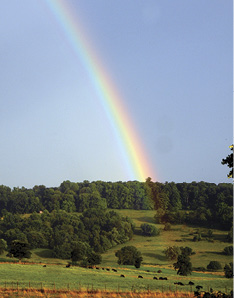Higher than normal rainfall amounts have farmers looking to the summer skies, for a different reason

As the middle of July roles around, most of the time in South Central Kentucky, farmers are looking to the skies and praying for rain.
Not so much the case this summer as Clinton County has more than seven inches of excess rain fall than what is normal during a recent 20 day cycle.
That particular cycle did not include rain totals in the area from weather systems that moved through the area on Monday and Tuesday of this week, dumping more precipitation across the county.
While rain is a good thing to keep farmer’s crops growing strong, too much rain can cause damage also and with several tobacco farmers in the area, flooding of the fields has been a huge problem.
“Most of the tobacco is where the issue is,” Colby Guffey, Extension Agent for Agriculture and Natural Resources, said. “The water logged soils have depleted oxygen. Oxygen is what the plant uses to cool itself when the sun comes out. If it has no oxygen, it can’t cool itself and that’s when it wilts down the stalk.”
Guffey said once this takes place in a tobacco plant, it’s hard to recover the crop.
“If you can get enough oxygen back in the soil it will survive,” Guffey said. “Usually by the next morning you will be able to tell if it’s going to be okay or not.”
Guffey said most of this year’s growing season has been A-typicial.
“We started off the season kind of wet and that delayed planting,” Guffey said. “Corn was probably pushed a little later than normal and once we did get the opportunity to plant some, they probably mudded some in and got some sidewall compaction, but now corn is looking really good. I know across the state, 83 percent of the corn crop is rated good to excellent.”
This year’s soybean crops are also looking good according to Guffey. Soybeans have nearly the same numbers as corn and is rated good to excellent on 82 percent of the state’s crop, however, in this area some of the beans are suffering because of the excess rainfall.
“When we were planting the early beans in the first part of May, it was really dry and some of those early beans had to be replanted,” Guffey said. “The beans now are being susceptible to fungal and bacterial pathogens. Producers need to weigh their options on fungicide applications.”
With the raining conditions, fungal and bacterial infestation can be an issue, but Guffey said there are no reports of anything in the state yet.
“There have been reports of blue mold in Tennessee and Pennsylvania, but nothing detected in Kentucky,” Guffey said. “Growers need to be diligent in scouting their fields and if they have any crops suspected of fungal growth, be sure to contact us here at the extension office so we can send it to the diagnostic lab and get confirmation.”
As of Friday, Guffey said there has been 11.5 to 12 inches of rainfall on Clinton County during the previous 20 day cycle, which is nearly seven inches above normal, according to rainfall totals gathered from the University of Kentucky.
“You rarely hear of farmers complaining about rainfall in the early summer months, but it’s almost too much of a good thing,” Guffey said.
Another aspect of having too much rainfall is farmers who rely on a hay crop to feed their cattle during the winter months.
With the excess of rain, many farmers have struggled to get their first cutting of hay to this point.
“Most farmers have got their first cut of hay, but it has been hard for others,” Guffey said. “We have a lot of folks who are part time farmers and they have a limited time to do that sort of thing. They look at the forecast and they give rain everyday so they hate to cut. If you go out now and cut with the ground saturated, you are not going to get it to dry. Hay quality is probably going to be down some this year. It wasn’t cut at the optimal time because of the weather.”
Guffey said the hay crop and tobacco has probably been hit the hardest so far, but with the limited amount of acreage for tobacco, percentage-wise, it did not add up to that much damage across the board.
Rain, rain . . .
A break in the near daily occurrences of thunderstorms in the area recently produced this rainbow late Monday afternoon. With the high price of beef this year that producers have enjoyed, the beef cattle in the bottom of the photo might be considered to be the “pot of gold” at the end of Monday’s rainbow.



